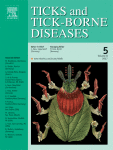Ver ítem
- xmlui.general.dspace_homeCentros Regionales y EEAsCentro Regional CorrientesEEA MercedesArtículos científicosxmlui.ArtifactBrowser.ItemViewer.trail
- Inicio
- Centros Regionales y EEAs
- Centro Regional Corrientes
- EEA Mercedes
- Artículos científicos
- Ver ítem
Mitigated clinical disease in water buffaloes experimentally infected with Babesia bovis
Resumen
Water buffaloes (Bubalus bubalis) are raised in tropical and subtropical regions of the world, and act as hosts of Babesia bovis parasites and the tick vector Rhipicephalus microplus. As no clinical cases of B. bovis-infection have been reported, we hypothesized that, unlike bovines, water buffaloes respond asymptomatically to an acute infection. To test this hypothesis, we inoculated two groups of 24-month-old Mediterranean breed water buffaloes with 108
[ver mas...]
Water buffaloes (Bubalus bubalis) are raised in tropical and subtropical regions of the world, and act as hosts of Babesia bovis parasites and the tick vector Rhipicephalus microplus. As no clinical cases of B. bovis-infection have been reported, we hypothesized that, unlike bovines, water buffaloes respond asymptomatically to an acute infection. To test this hypothesis, we inoculated two groups of 24-month-old Mediterranean breed water buffaloes with 108 erythrocytes infected with two Argentine B. bovis isolates: BboM2P (n = 5) or BboS2P (n = 5). These strains displayed mild (BboM2P) or high (BboS2P) pathogenicity in Bos taurus calves of the same age (n = 5 and n = 1, respectively), when tested in parallel. In water buffaloes, no changes in body temperature were observed with both strains, and no hematocrit changes were detected in BboM2P-inoculated animals. In contrast, in the BboS2P-inoculated water buffalo group significant but relatively minor reductions in haematocrit values were noted compared to the infected bovine. The parasitemia attained in water buffaloes was considerably lower than in bovines and could only be detected by nested PCR, or indirectly via serology, whereas in most bovines, it could also be detected in Giemsa-stained smears under the light microscope. Our results show that water buffaloes present no or significantly mitigated clinical symptoms to B. bovis infections and suggest that they are able to substantially reduce and/or eliminate B. bovis parasites from circulation by an efficient innate immune mechanism.
[Cerrar]

Fuente
Ticks and Tick-borne Diseases 9 (5) : 1358-1363 (July 2018)
Fecha
2018-07
ISSN
1877-959X
1877-9603
1877-9603
Formato
pdf
Tipo de documento
artículo
Palabras Claves
Derechos de acceso
Restringido
 Excepto donde se diga explicitamente, este item se publica bajo la siguiente descripción: Creative Commons Attribution-NonCommercial-ShareAlike 2.5 Unported (CC BY-NC-SA 2.5)
Excepto donde se diga explicitamente, este item se publica bajo la siguiente descripción: Creative Commons Attribution-NonCommercial-ShareAlike 2.5 Unported (CC BY-NC-SA 2.5)

